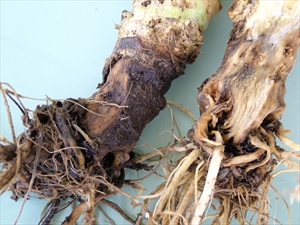Fusarium wilt of cabbage, Fusarium yellows, brassica Fusarium wilt
Pacific Pests, Pathogens, Weeds & Pesticides - Online edition
Pacific Pests, Pathogens, Weeds & Pesticides
Cabbage Fusarium yellows wilt (132)
Fusarium oxysporum f.sp. conglutinans. There are several strains of the fungus.
Asia, Africa, North, South and Central America, Europe, Oceania. It is recorded from American Samoa, Australia, New Caledonia, New Zealand, and Samoa.
Members of the cabbage (brassica) family, e.g., broccoli, Brussels sprout, cabbage, cauliflower, and Chinese cabbage.
The disease starts with the infection of the fine roots, and then the fungus enters the vascular system of the plant (Photo 1). The vascular system transports water and food inside the plant, and this becomes blocked by the growth of the fungus. If the stem is cut across at soil level a brown stain is seen in the vascular system; often this browning is more obvious on one side.
Above ground the disease is seen as a slow wilt. Symptoms start on the lower leaves and move upwards; leaves of young plants twist and become yellow on one side, and eventually the affected leaves turn brown and drop prematurely. Plants may survive and be severely stunted, or under conditions favourable for the disease (temperatures of about 27°C) the plants are killed. Soil moisture and pH have little effect on the fungus.
The fungus spreads in a number of ways. Spores are produced both outside and inside the plants and these are spread in water and soil. The fungus spreads in infected seedlings and soil from the nursery, and also in soil on machinery or footwear.
The Fusarium wilt fungus can survive in the soil for many years growing on the remains of crops or on the roots of weeds.
Fusarium wilt is a major disease; losses are reported to be high in susceptible varieties. Cabbage is the main crop affected by the disease, but many other brassicas are also susceptible. Seedlings may die rapidly after transplanting, whereas surviving plants become deformed and stunted due to root decay. Poor seed set occurs on those brassicas that are grown for their seed, e.g., mustard and canola.
Look for the rotten roots system, and the discoloration of the vascular system of the main stem; this is the key diagnostic symptom. Look for yellowing of the leaves from the bottom upwards. Look for the one-side growth of the plant. Note that the veins in the leaf turn brown, but not black as occurs in black rot (see Fact Sheet no. 131).
CULTURAL CONTROL
There are two main ways of controlling this disease. If it is already in the soil, grow varieties that have resistance or tolerance; if the soil is not infested with the fungus, prevent its spread to clean fields by washing soil from machinery, tools and shoes.
Before planting:
- Nursery practices:
- Decontaminate seedling trays by dipping them in household bleach (1 part bleach to 9 parts water) for 15-20 minutes, rinse and dry.
- Raise nursery plants in soil-less potting mix, or pasteurised soil mixes.
- Keep nursery areas at distance from fields where cabbage (and other brassica) crops are grown.
- Inspect seedlings frequently; if infections occur, destroy the seedlings and those in a buffer region around.
- Select well-drained fields, and plant on raised beds. Also, make sure plants will not receive surface run-off water from infested fields.
- Do not grow brassicas in the same field each year, use a rotation involving lettuce, capsicums, tomatoes or a root crop to prevent build up of the fungus in the soil.
RESISTANT VARIETIES
Cabbage, is the major crop affected by Fusarium wilt, but other brassicas are also susceptible, e.g., cauliflower, broccoli, radish. There are resistant varieties and usually they provide good control.
CHEMICAL CONTROL
Chemical control is not recommended for this disease.
AUTHOR Grahame Jackson
Information (and Photo 1) Diseases of vegetable crops in Australia (2010). Editors, Denis Persley, et al. CSIRO Publishing; and from CABI (2019) Fusarium oxysporium f.sp. conglutinans (cabbage fusarium wilt). Crop Protection Compendium. (https://www.cabi.org/cpc/datasheet/24632).
Produced with support from the Australian Centre for International Agricultural Research under project PC/2010/090: Strengthening integrated crop management research in the Pacific Islands in support of sustainable intensification of high-value crop production, implemented by the University of Queensland and the Secretariat of the Pacific Community.




